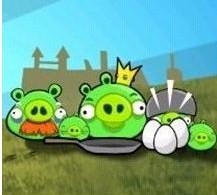(Version in 中文)
It was pretty clear to me on a recent visit that China has become one of the biggest global markets for Angry Birds. The game was everywhere and around 100 million Chinese downloads are expected this year. It made me wonder if this was somehow linked to rising concerns over inflation and a way of getting back at those (increasingly expensive) mischievous green pigs.
 During the past year, views on China’s economy have yo-yoed from concerns about the recovery, to hand-wringing about inflation and overheating, and then back to talk of hard landing.
During the past year, views on China’s economy have yo-yoed from concerns about the recovery, to hand-wringing about inflation and overheating, and then back to talk of hard landing.
Certainly inflation has been a key feature of the environment this year in China and one should pay close attention to it. Rising inflation is a crucial social concern and takes a heavy toll on household incomes that are already struggling to keep up with economic growth.
Overheating?
Here at the IMF, the China team’s view—surprising though it may be to some—has been that Chinese inflation should peak in the middle of this year and, by late-2011, move on to a declining trend. No reason, then, to get too excited about inflation.
But then we get asked a lot “how does a red hot Chinese economy manage to escape inflation and defy the economic laws of gravity that other economies face?”
The first thing to note is that China continues to have chronic excess capacity in a range of highly competitive manufacturing sectors. This leaves companies with little pricing power, diluting the inflationary impetus from strong demand. At the same time, there is still an overall excess supply of labor in China (despite shortages of highly skilled workers) and this helps keep wage growth from getting too far ahead of productivity. It would be pretty unlikely for an economy that is investing almost half of its GDP and has a structural surplus of labor to hit meaningful capacity constraints and “overheat” in the usual sense. Bottlenecks? Yes. Skills gaps? Certainly. Generalized overheating? No.
That’s not to say there’s no inflation problem. Demand pressures in China manifest themselves in two very different ways. The first is through asset price inflation, notably property prices. The economy does well and house prices shoot up. Policymakers then have to step in with administrative measures to restrain the bubble. (I wrote about this recently.)
Feasting on inflation
Second, China faces large and volatile inflationary impulses from food. Why is inflation so concentrated in this particular slice of the consumption basket? Mainly because the supply-demand balance for food in China is exceptionally tight and the supply response to higher food prices is both slow and weak. This makes for a precarious mix where any disruption in domestic supply—due to weather or disease—immediately translates into an amplified impact on raw food prices. Rising global prices for food only make the overall situation more difficult.
This isn’t simply a matter of importing more food to offset domestic supply disruptions. China’s food demands are just way too big. China both produces and consumes one-sixth of the world’s wheat, one-fifth of the world’s corn, one-third of the world’s rice, and one-half of the world’s pigs. Equally, the structure of China’s agricultural industry and the limited availability of agricultural land hamper an effective domestic supply response (on these deeper issues Stephen Green has produced a series of great analytical pieces).
So China finds itself exposed to large and random food shocks, mostly domestically driven, which sporadically batter the consumer price index. The initial impact from shocks to raw food then seeps into other parts of the consumption basket, shows up for a bit in nonfood inflation, and dissipates after about 6-12 months. While macroeconomic policy can help dampen the pass-through from food to other items, it can do little to counter the fundamental source of these pressures.
Coming back to the most recent inflationary episode. Our take is that the initial shock this time around materialized in fresh fruit, vegetables and grain in the first half of 2010, due mostly to weather. Toward the end of 2010 we saw inflation start to feed through to other items in the consumption basket, coinciding with a moderate easing of credit conditions around the same time. By the Spring of this year, the momentum was starting to fizzle, partly dampened by a tightening of macroeconomic policies. Inflation peaked in July and was all set to quickly retreat in the latter part of this year.
Pork happens
Unfortunately, just as China appeared to be heading out of the (inflationary) woods, pork happened. An ongoing (and literal) hog cycle, embellished by some localized pig disease, caused pork prices to skyrocket. We are now seeing this feed back into inflation more broadly, starting up the transmission mechanism again. Given that this process is well underway, it would seem premature to now start to backpedal on macroeconomic policies.
The good news is that this particular food price shock should be smaller than in the past; the hog-cycle will soon turn and the effects should wash out reasonably quickly. The bad news, though, is that the return to more normal times and lower inflation will be postponed once again. Darn them piggies!





